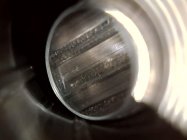I've spoken with some pretty sharp people on this subject and most agree that temp is a big factor BUT not the only factor. Under extreme heat, the bbl is also expanding and contracting under pressure. They, and I agree, this expansion and contracting plays a role in what we see on the shallow surface of the bore. So, I think attributing it only to heat, is likely not completely the case, but certainly it factors largely into it.
I'm playing with a couple of reamers now that may help in regard to the heat and flame aspect. I'm simply laying the 45° angle at the chamber case mouth..end of chamber, from 45° to 15°. The whole idea is a much larger heat sink area as well as a far smoother step for the flame to flow over, as opposed to a very abrupt 45° step. Time will tell. I have seen no detriment to accuracy but still early. Way too early to see what affect it may have on bbl life, but that's the main objective behind it.
I've mentioned this a few times but will again... When S&W introduced their big 500 Mag revolvers, flame cutting of the top strap of the frame, above the cylinder gap, was a real issue. Their engineers cured it by simply polishing the inside of that area of the frame, allowing the flame to smoothly flow over and around without the rough eges that were there before, which started the cut and exacerbated it. Same principle with these reamers. Pretty much exactly but carrying it a little further.











